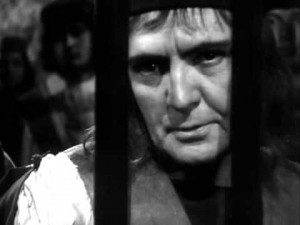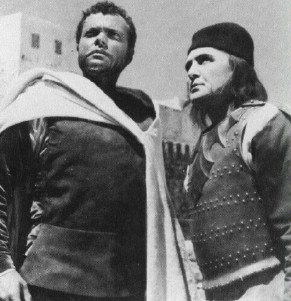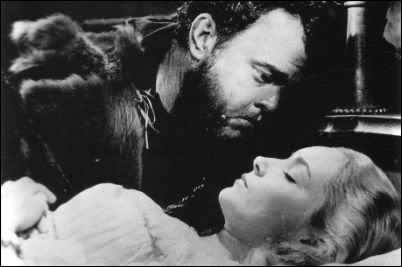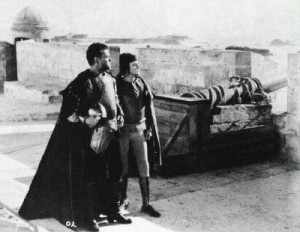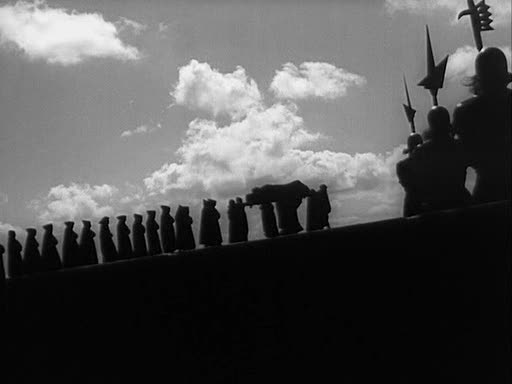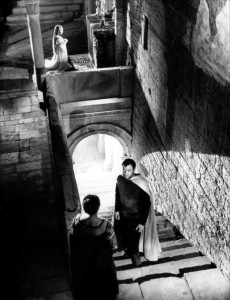From Sight and Sound (October 1992). –- J.R.
Most of the American press has been all too happy to declare the new version of Orson Welles’ Othello as “expertly restored”, as Vincent Canby put it in the New York Times. But restored from what and to what? Even rudimentary information about the film’s original form is not easy to come by in the U.S., where 0thello brought in only $40,000 on its belated first release in 1955 and has been screened only sporadically since. Mutatis mutandis, the acclaim that has greeted the restoration recalls the unqualified press endorsements of Francis Coppola’s presentation of Abel Gance’s ‘complete’ Napoléon at Radio City Music Hall in 1981, in a version that eliminated an entire subplot so that the print wouldn’t run past midnight and jack up the theatre’s operating costs.
To make matters more complicated, two different versions of the ‘restored’ Othello have been presented to the public so far, although only the second of these is currently in circulation. The first, worked on in Chicago by a team headed by Michael Dawson and Arnie Saks, premiered at New York’s Lincoln Center late last year; I saw it several weeks afterwards at a private screening in Chicago. The second, which was worked on in New York, was commercially released by Castle Hill Films in April. The philosophy underlying these two ‘restorations’ is similar and the differences between the two prints are slight — the Dawson/Saks version favors a more prominent use of music and sound effects; the Castle Hill version makes the dialogue more audible, has omitted some material from the opening sequence and, in visual terms, has altered the contrast.
Unlike the ‘complete’ Napoléon, neither version can be accused of deleting major footage from Othello. The issues, rather, relate to the artistic changes — including both additions and subtractions — that transpired once it was decided to resynchronize the dialogue, refashion the music and sound effects in stereo, and reset the timing (i.e. visual contrasts) without adhering to Welles’ own specifications (given in relation to a fine-grain print held by the Library of Congress). Without claiming any specialist knowledge of the technical processes involved, I don’t think it would be an exaggeration to describe the new Othello(s) as post-modernist alterations of the original rather than as ‘restorations’, in any dictionary sense of that term.But considering the post-modernist reductions of the past that already proliferate, this may prove a moot point for the general public.
In any case, most people will have to choose between seeing a new version of Welles’ masterpiece or none at all — and I don’t mean to be churlish about the revival of a remarkable film that remains to my mind one of Welles’ greatest works in any version, and is fundamental to a comprehensive understanding of his oeuvre. Othello set in motion the whole ‘second manner’ of Welles’ filmmaking career –- developed after he moved to Europe in the late 40s and became an independent — a manner that relied largely on haphazard and scattered location shooting followed by lengthy bouts of editing. And it seems clear that every Welles film made after Othello — including Touch of Evil (1958), his last Hollywood picture — is substantially different because of it.
Always a scandal
A struggle has been waged since the initial release of Citizen Kane (1947) about whether to read Welles’ films as mainstream Hollywood or as subversive independent productions. Admitted1y, a certain ambiguity about Welles as an independent artist can be traced back to his theatre work in the 30s, when he was surreptitiously helping to finance some of his WPA stage productions, all officially government-supported, with his fees as a radio actor. It was surely Welles’ mainstream reputation during this period that set the tone for his commercial self-image in movies afterwards, despite the fact that none of his features ever enjoyed a mainstream success. The fact that all his serious filmmaking wound up subverting the ‘cinematic apparatus’ in diverse ways wasn’t always part of his intentions, but it has dictated the contradictory reception of his work in the mainstream ever since.
Over three years passed between Othello sharing the Palme d’Or at Cannes with Two Cents Worth of Hope in 1952 and its inauspicious U.S. release, when it was compared unfavorably by most reviewers to Laurence Olivier’s Shakespeare films — a response already elicited by Welles’ Macbeth (1948). The critical objections lodged against the two films were practically identical: that Welles had done violence to the Shakespeare text, indulged himself, and made many of the lines unclear.
The main reason why the dialogue was supposedly unclear in Macbeth was the Scots accents, and Welles was obliged to edit and redub a second version without them. In the process we lost the first ten-minute take (the original version is now available on video in the U.S., and the lines are perfectly clear to anyone who cares to listen). The lack of clarity in Othello was blamed partly on faulty lip synch, most of which has been eliminated thanks to the painstaking work done in Chicago. Frankly, I’ve always thought that both ‘problems’ were excuses for people intimidated by Shakespeare or by Welles’ reluctance to approach the playwright on his knees.
But if we recall that the Latin root of ‘amateur’ is amare, ‘to love’, Welles’ romantic, impractical and passionate commitment to his work — quite the opposite of Olivier’s bloodless professionalism — was the real scandal. And in comparison with most goods pushed by the Hollywood propaganda machine — which currently enjoys almost unlimited free publicity in the U.S., in both the media and in many branches of academia (where ‘classical Hollywood cinema and ‘the genius of the system’ are.
fashionable buzz terms) — Othello remains a scandal today. Consider the response of drama critic Eric Bentley back in 1955: “[A] film bad from every point of view and for every public. Technically, it is gauche, the dialogue being all too obviously dubbed. It lacks popular appeal, as the story is neither simply nor skillfully told. To connoisseurs of Shakespeare, it can only be torture… I don t know what The Daily Worker said, but it missed a trick if it didn’t hold up Mr. Welles as a prize example of individualistic, bourgeois culture in decay”.
In retrospect, I think one can see what makes Welles’ first unambiguously independent film an act of even greater courage and defiance than Citizen Kane. Ln Kane, he was bucking only Hollywood and Hearst; with Othello he was defying both Hollywood and academia — not to mention the whole institutional set-up for picture-making, as it was then dimly understood. Properly speaking, he had entered the treacherous domain of the avant-garde — probably against his own conscious wishes –and a substantial portion of the American intelligentsia never forgave him for it. From then on, with the exception of Touch of Evil, he would make features only with the support of foreign producers, and not very many of these; otherwise he had to finance them himself.
Outside Hollywood
The recent efforts to bring Othello closer to a contemporary mainstream release grow directly out of its initial rejection. Ironically, the creative disorder and ideological disturbances offered by both Welles’ art and career, which continue to account for an enormous portion of his appeal, also throw up obstacles for anyone — including Welles himself when he was alive — hoping to cash in on this appeal. The same complex forces that kept Welles unemployed as a filmmaker for most of his working life — and continue to keep films like The Other Side of the Wind and Don Quixote beyond our reach — also play a significant role in preventing his ‘classics’ from reaching us in their original form. Consider the new prints of Citizen Kane struck last year, supervised by none other than Robert Wise, whose mainstream ‘improvements’ on Welles stretch back to The Magnificent Ambersons (1942). As one of Welles’ most faithful early collaborators was quick to point out to me, the ‘News on the March’ sequence in the new version of Kane is printed to look less grainy, while the projection-room sequence has been made too bright, both changes that constitute a reduction in Welles’ departures from Hollywood norms.
The mainstream versus independent argument affects both the quality and quantity of information we have about Welles’ films. For instance, a central part of the agenda of Pauline Kael’s highly influential Raising Kane (1971), designed largely as a riposte to Andrew Sarris’ auteurism, was to redefine the film as a mainstream Hollywood effort (rather than an independent effort that used Hollywood studio facilities), establishing Hollywood screenwriter Herman J. Mankiewicz, rather than maverick independent Welles, as its key auteur. (If Hollywood could produce a Kane, ran Kael’s implicit argument, then maybe the system wasn‘t so corrupt as Welles’ experience implied.) Even Robert L. Carringer’s The Making of ‘Citizen Kane’ (1985), which corrected some of Kael’s slipshod scholarship, furthered the mainstream treatment of the film, with the result that a Hollywoodized Welles has become the unexamined staple of today’s critical orthodoxy – despite the fact that the six studio pictures he directed represent at best only about a third of his completed movies and a quarter of his total film output. Thanks to this bias, the remainder of Welles’ oeuvre — including Othello — has often had to go begging.
Is it a new movie?
Clearly one of the things that drove Welles into independence was a desire to recut his own material, with the result that ‘definitive’versions of many of his films are impossible to establish. In the case of Othello at least two distinct versions exist three if we count the material used in the essay film Filming ‘Othello’ (1978), which resynchronizes the music in the opening sequence and recuts everything else. My own recent research suggests that Welles preferred the version featuring his spoken credits after the opening funeral sequence, but with no narration. Unfortunately neither the Dawson/Saks nor the Castle Hill versions follows this format: indeed, Dawson and Saks were unaware of its existence until their work was virtually complete. (So was I, for that matter; in fact, I owe my discovery of this cut to Dawson.) The negative they found in a New Jersey warehouse and which formed the basis of their work contains Welles’ off-screen narration after the opening funeral sequence, printed credits at the end of the film, and somewhat different editing throughout.
As a Chicago resident, I was able to follow portions of the Dawson/Saks restoration work at various stages, and I can vouch for the team’s fanatical scrupulousness about using the most up-to-date technology, and for their relative indifference to matters of historical research. (Apart from the Library of Congress, for instance, no film archives were consulted.) In some ways, their philosophy is allied with the myth that wants to remove Welles from the disreputable independent sector and plant him squarely inside the same mainstream that rejected him during his lifetime.
An example of this myth in action is the assumption, implicit in the refurbished Othello, that the only reason Welles didn’t use stereo was that it was technically unavailable to him, and that the way he would have used it conforms precisely to today’s commercial norms. My own research has revealed that Welles briefly explored the possibility of recording Macbeth in stereo, but has thrown up no clues as to how he might have used it. But considering his eclecticism and originality, as well as his prodigious radio experience, I seriously doubt that it would have been in the way it is used in the new Othello. The dynamic relationships between dialogue, music and sound effects in the original have all been substantially altered: to put it bluntly, the new version sounds like a different movie, and state-of-the-art equipment or not, a lesser one.
Stroking the strings
When it came to ‘restoring’ the music, no attempt was made to locate the manuscript of Francesco Lavagnino and Alberto Barberis’ score. Michael Pendowski, a Chicago Symphony conductor, was hired to listen to the music, transcribe what he heard, and record it with new musicians. Similar work was done by other technicians in imitating the original sound effects — with the waves of Lake Michigan, for instance, standing in for those of the Mediterranean. Moreover, the technicians working on the music and sound effects did so in isolation, with no apparent attempt to conceive of these as part of the same aesthetic whole.
A paragraph from Charles Higham’s Orson Welles: The Rise and Fall of an American Genius (1985) is worth citing as one of the only pieces of information we have in English about the recording of Lavagnino’s music, most or all of it apparently drawn from an interview with Lavagnino himself: “Welles demanded an orchestra of two hundred, which was conducted by Franco Ferrara… When the work was completed, Welles was still passionately involved with changes. He was unhappy with the funeral music, feeling that it sounded like ‘Tchaikovsky touring in Italy’; consequently it was rescored for harpsichord, and Lavagnino worked with the only harpsichord available in Rome. Lavagnino recorded the dirge with sixteen instruments and eight voices by placing three microphones to create the right music perspective”.
Ciro Giorgini, who has recently been interviewing the original Othello crew members for an Italian documentary, informed me that according to one of the production assistants, Welles personally stroked the strings inside a piano to achieve a sound effect for the funeral sequence, and ordered a spinetta, an ancient form of harmonium from Florence, for certain effects elsewhere. In 1969, Welles recalled to Peter Bogdanovich that as many as forty mandolins were used at one time, presumably in the Turkish-bath sequence.
If, however, one believes in the supremacy of Hollywood production values over such details, there is no problem in accepting the fact that no spinetta or stroked strings or three strategically placed microphones or forty mandolins play any role in either of the new Othello soundtracks. Pendowski told me that he heard at most only three or four mandolins at any one time in the original, so that’s all we hear in the new versions. Of course, spectators seeing Othello for the first time in the ‘restored’ version won’t have the chance to choose between Welles’ ear working with inferior technology, and Pendowski’s working with superior equipment. Even with the best will and mimicry in the world (as well as the use of the original music as a ‘guide track’), most of the precise elements of music and sound effects as supervised by Welles are no longer part of the film.
There’s also the matter of the chanting of Latin by monks in the funeral procession of the opening sequence — a prolonged, hushed recitation that serves effectively both as diminuendo after the music ends and as a tapering sound bridge to the silence that follows in both Welles-edited versions. This chanting was still in the penultimate version of the Dawson/Saks restoration, but has disappeared from the Castle Hill version. Why this major part of Welles’ sound design was deleted is anyone’s guess, although I’m told that it will be restored in the video and laser-disc versions. If such a correction leads to some reflection about the dangers of unlimited trust in technology over research, we may have less to worry about when it comes to future restorations, including one currently contemplated for Chimes at Midnight.


